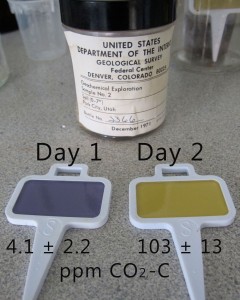
ARCHIVED STORED SOIL. After 44 years in storage, a USGS soil sample need only 1 extra day to come back alive.
How long can a dry soil be stored and microbes remain viable? Many persons who have stored soil samples dating back decades have asked us this question.
We recently had a chance to test the “dead soil” hypothesis. Staffer Bob Burger uncovered his old archive of US Geologic Survey soil samples, dating from 1971. One sample of interest was a 0-7” topsoil collected in Park City, Utah. It had been dried, milled and left sealed in the glass jar ever since then. Using our standard Solvita method, we opened the jar, added water and ran the Solvita CO2-burst test (in triplicate).
We observed virtually no microbial activity in the first 24-hrs – suggesting that the soil had indeed “died”. However, when we allowed it to go another 24hrs it burst into life. We repeated this sequence 3 times – no activity in the first 24 hrs and a full-blown CO2-response in the second, 24hr period. Once enlivened in this way, even after re-drying the soil behaved normally with CO2-bursts in the first 24hrs.
In this old 44 year sample the microbes needed 1 extra day to come out of senescence, and return to what appears to be normal activity. That’s sustainable microbial potential!

